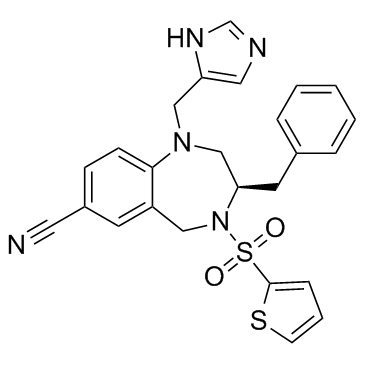| Description |
BMS-214662 is a potent and selective farnesyl transferase inhibitor with potent antitumor activity with an IC50 of 1.35 nM.
|
| Related Catalog |
|
| Target |
IC50: 1.35 nM (farnesyl transferase), 1.3 μM (Ras-CVLL), 2.3 μM (K-Ras)[1]
|
| In Vitro |
BMS-214662 is over 1000-fold selective for farnesyl transferase, having IC50 values for inhibition of geranylgeranylation of Ras-CVLL and K-Ras of 1.3 and 2.3 μM, respectively[1]. BMS-214662 shows good potency in inhibiting H-ras-transformed rodent cells, A2780 human ovarian carcinoma tumor cells, and HCT-116 human colon carcinoma tumor cells. BMS-214662 is the most potent apoptotic FTI known and demonstrates broad spectrum yet robust cell-selective cytotoxic activity against a panel of cell lines with diverse histology[2].
|
| In Vivo |
Tumors from BMS-214662-treated mice have increased numbers of apoptotic cells as compared with the nontreated control mice. The AIs in HCT-116 tumors are increased 4-10-fold in BMS-214662-treated mice as compared with nontreated controls. BMS-214662 is significantly cytotoxic to both HCT-116 and EJ-1 tumor cells; the doses of BMS-214662 required to kill 90% of clonogenic tumor cells are approximately 75 and 100 mg/kg for HCT-116 and EJ-1 tumors[2].
|
| Cell Assay |
The hydrochloride salt of BMS-214662 is dissolved in DMSO with dilutions made using either water or RPMI 1640 plus 10% fetal bovine serum. BMS-214662 is added at various concentrations. The cells are incubated at 37°C for 72 h, at which time MTS in combination with phenazine methosulfate is added. After an additional 3 h, the absorbance is measured at 492 nm, and the growth inhibition results are eventually expressed as IC50s[2].
|
| Animal Admin |
Mice: BMS-214662 is dissolved in ethanol, followed by dilution with water to a final ethanol concentration of 10%. Mice implanted with HCT-116 xenografts are administered a single dose of BMS-214662 at 250 mg/kg i.v., 300 mg/kg i.p., or 400 mg/kg p.o. An additional group receives 400 mg/kg BMS-214662 daily for 2 days (administered p.o. on day 1 and i.p. on day 2). Nontreated mice with time-matched HCT-116 tumors served as controls. Tumors are collected at 24 h after dose, processed following standard methods, sectioned, and stained with H&E. Serial sections of each tumor are processed for in situ apoptotic cell labeling by the TUNEL method[2].
|
| References |
[1]. Hunt JT, et al. Discovery of (R)-7-cyano-2,3,4, 5-tetrahydro-1-(1H-imidazol-4-ylmethyl)-3- (phenylmethyl)-4-(2-thienylsulfonyl)-1H-1,4-benzodiazepine (BMS-214662), a farnesyltransferase inhibitor with potent preclinical antitumor activity. J Med Chem. 2000 Oct 5;43(20):3587-95. [2]. Rose WC, et al. Preclinical antitumor activity of BMS-214662, a highly apoptotic and novel farnesyltransferase inhibitor. Cancer Res. 2001 Oct 15;61(20):7507-17.
|
